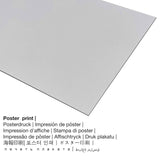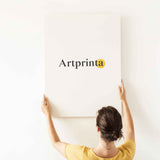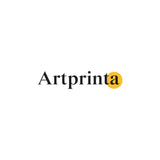Nicolai Abildgaard, 1803 - Simo and his former slave Sosia - fine art print
Tax included. Shipping calculated at checkout.
Product summarization
In the year 1803 Nicolai Abildgaard painted the artpiece. Moveover, this artwork is included in the Statens Museum for Kunst (National Gallery of Denmark)'s digital collection in Copenhagen, Denmark. This public domain artwork is supplied with courtesy of National Gallery of Denmark.: . Further, the alignment of the digital reproduction is portrait and has an image ratio of 1 : 1.2, which means that the length is 20% shorter than the width. Nicolai Abildgaard was a male painter, whose artistic style can mainly be classified as Romanticism. The Danish painter lived for a total of 66 years and was born in the year 1743 in Copenhagen and passed away in 1809.
Additional information on the original artwork from Statens Museum for Kunst (National Gallery of Denmark) (© - Statens Museum for Kunst (National Gallery of Denmark) - Statens Museum for Kunst (National Gallery of Denmark))
After a broken and unhappy marriage, Abildgaard met his second wife Juliane Marie some time before 1800. This new, reinvigorating relationship introduced new themes in his art, leading him to address aspects of love.
Scenes from Terence's romantic comedy During the time after 1800 he created four large canvases to be placed in the residence provided for the couple at the Royal Academy of Fine Arts at Charlottenborg, filling them with scenes from the ancient writer Terence’s romantic comedy Andria.
Connection between Terence and Abildgaard In the painter’s version of the complicated dramatic intrigues, they begin when the central character, Simo, asks his black chef Sosia to pretend that he is hastening the marriage of Simo’s son.
The scene in the foreground links Terence and Abildgaard through a sequence of allusions: Terence was a slave who had been given his freedom, and in the picture Abildgaard based the black chef’s appearance on a medal that he himself designed on the occasion of the Danish ban on slavery.
In the play the chef is in fact also a liberated slave, and the playwright was from Africa himself. In the last picture in the series, Abildgaard makes an appearance accompanied by his wife and child – providing a kind of counter-signature to balance out the first picture’s introduction of the playwright.
Details on the unique artwork
| Painting title: | "Simo and his former slave Sosia" |
| Categorization of the artpiece: | painting |
| Category: | modern art |
| Temporal classification: | 19th century |
| Year: | 1803 |
| Artwork age: | over 210 years old |
| Exhibited in: | Statens Museum for Kunst (National Gallery of Denmark) |
| Museum location: | Copenhagen, Denmark |
| Museum's webpage: | Statens Museum for Kunst (National Gallery of Denmark) |
| Artwork license type: | public domain |
| Courtesy of: | National Gallery of Denmark |
Brief overview of the artist
| Name: | Nicolai Abildgaard |
| Gender of the artist: | male |
| Nationality of artist: | Danish |
| Professions of the artist: | painter |
| Home country: | Denmark |
| Classification: | modern artist |
| Art styles: | Romanticism |
| Died at the age of: | 66 years |
| Born in the year: | 1743 |
| Hometown: | Copenhagen |
| Died: | 1809 |
| Deceased in (place): | Copenhagen |
Pick your product material variant
For every fine art print we offer different materials & sizes. We allow yout to choose among the following variants:
- The canvas print: The canvas print, not to be mistaken with a painting on a canvas, is a digital copy printed on a UV direct printer. It has the plastic effect of three-dimensionality. The great advantage of canvas prints is that they are relatively low in weight, which implies that it is easy to hang your Canvas print without additional wall-mounts. A canvas print is suited for any type of wall.
- Glossy acrylic glass print (with real glass coating): An acrylic glass print, often referred to as a fine art print on plexiglass, will turn the original artwork into décor. Your favorite artwork is printed with the help of modern UV printing technology. It makes sharp and rich color shades. The great advantage of an acrylic glass art print is that sharp contrasts and small painting details will be exposed with the help of the delicate tonal gradation. Our real glass coating protects your custom fine art print against light and external influences for many years.
- Aluminium dibond print: An Aluminium Dibond print is a material with an impressive effect of depth. For your Direct Print On Aluminum Dibond, we print your selected artwork on the surface of the white-primed aluminum composite. The colors of the print are bright and vivid, the details of the print appear very clear, and you can perceive a matte appearance of the fine art print.
- Printed poster (canvas material): The Artprinta poster is a printed canvas paper with a nice surface structure. Please note, that depending on the size of the poster print we add a white margin of approximately 2-6 cm round about the work of art, which facilitates the framing.
The product specifications
| Product type: | art print |
| Reproduction: | reproduction in digital format |
| Manufacturing process: | UV direct print (digital printing) |
| Production: | manufactured in Germany |
| Stock type: | on demand production |
| Intended product usage: | wall gallery, art reproduction gallery |
| Orientation: | portrait format |
| Image ratio: | (length : width) 1 : 1.2 |
| Meaning: | the length is 20% shorter than the width |
| Materials: | poster print (canvas paper), acrylic glass print (with real glass coating), canvas print, metal print (aluminium dibond) |
| Canvas on stretcher frame (canvas print) variants: | 50x60cm - 20x24", 100x120cm - 39x47", 150x180cm - 59x71" |
| Acrylic glass print (with real glass coating) options: | 50x60cm - 20x24", 100x120cm - 39x47", 150x180cm - 59x71" |
| Poster print (canvas paper) sizes: | 50x60cm - 20x24", 100x120cm - 39x47" |
| Aluminium dibond print (aluminium material) size options: | 50x60cm - 20x24", 100x120cm - 39x47" |
| Framing of the art copy: | unframed reproduction |
Important legal note: We try everything in order to describe the art products as precisely as possible and to demonstrate them visually on the product detail pages. Although, the pigments of the printing material and the print result can diverge slightly from the image on your screen. Depending on your settings of your screen and the quality of the surface, color pigments can unfortunately not be printed 100% realistically. Given that all are processed and printed manually, there might as well be minor deviations in the exact position and the size of the motif.
© Copyright of - Artprinta (www.artprinta.com)














